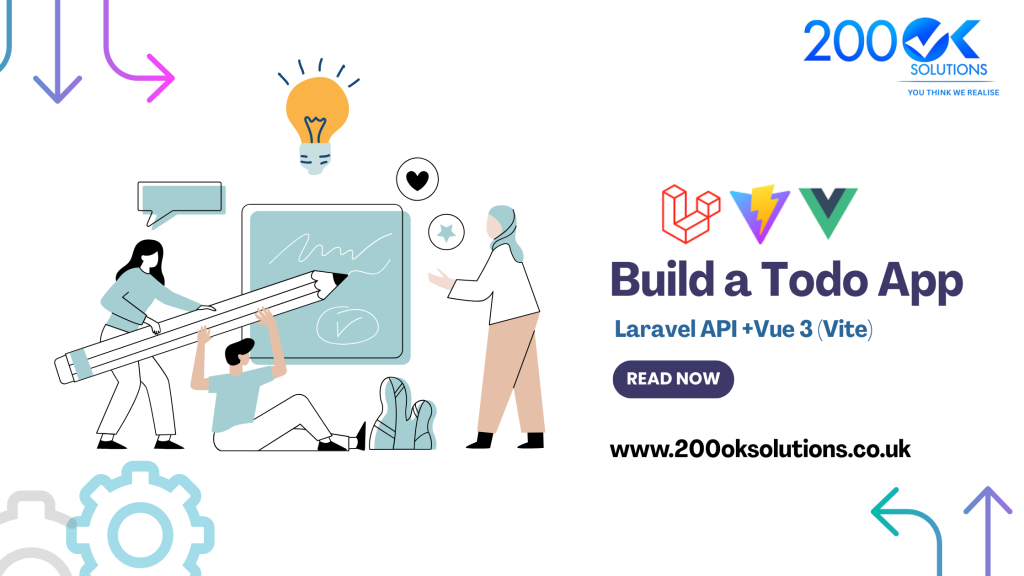
Build a simple but complete Todo CRUD application using Laravel as a JSON API and Vue 3 (Vite) as the frontend SPA — using modern Vue features (<script setup>), Pinia for state, and Axios for API calls. This tutorial is aimed at developers who want a practical, production-ready starter.
Prerequisites
- Node.js 16+ (Node 18+ recommended)
- npm or pnpm or yarn (we’ll use npm in commands)
- PHP 8.1+
- Composer
- MySQL (or other DB) and basic knowledge of creating databases
- Optional: XAMPP / Valet / Docker — any local PHP environment that can run Laravel.
1: Project layout & approach
We’ll create two projects in sibling folders:
workspace/
├─ todo-api/ # Laravel backend (API)
└─ todo-vue/ # Vue 3 frontend (Vite)2: Create Laravel API (todo-api)
2.1 Create project
composer create-project laravel/laravel todo-api
cd todo-api
php artisan key:generate2.2 Configure database
Open .env and set DB credentials:
DB_CONNECTION=mysql
DB_HOST=127.0.0.1
DB_PORT=3306
DB_DATABASE=todo_api
DB_USERNAME=root
DB_PASSWORD=your_passwordCreate the todo_api database in MySQL
2.3 Create model & migration
php artisan make:model Task -mEdit the generated migration (database/migrations/xxxx_xx_xx_create_tasks_table.php):
Schema::create('tasks', function (Blueprint $table) {
$table->id();
$table->string('title');
$table->text('description')->nullable();
$table->boolean('completed')->default(false);
$table->timestamps();
});
php artisan migrate2.4 Add fillable to model
app/Models/Task.php:
<?php
namespace App\Models;
use Illuminate\Database\Eloquent\Model;
class Task extends Model
{
protected $fillable = ['title', 'description', 'completed'];
}2.5 Create API controller
php artisan make:controller Api/TaskController --apiReplace app/Http/Controllers/Api/TaskController.php with:
<?php
namespace App\Http\Controllers\Api;
use App\Http\Controllers\Controller;
use App\Models\Task;
use Illuminate\Http\Request;
class TaskController extends Controller
{
public function index()
{
return Task::latest()->get();
}
public function store(Request $request)
{
$data = $request->validate([
'title' => 'required|string|max:255',
'description' => 'nullable|string'
]);
$task = Task::create($data);
return response()->json($task, 201);
}
public function show(Task $task)
{
return $task;
}
public function update(Request $request, Task $task)
{
$data = $request->validate([
'title' => 'required|string|max:255',
'description' => 'nullable|string',
'completed' => 'boolean'
]);
$task->update($data);
return $task;
}
public function destroy(Task $task)
{
$task->delete();
return response()->noContent();
}
}2.6 API routes
In routes/api.php:
use App\Http\Controllers\Api\TaskController;
Route::apiResource('tasks', TaskController::class);2.7 Allow cross-origin requests (CORS) for local dev
Laravel includes CORS config in config/cors.php. For simple local dev, set:
'paths' => ['api/*'],
'allowed_origins' => ['http://localhost:5173'], // Vue dev server
'allowed_methods' => ['*'],
'allowed_headers' => ['*'],2.8 Run Laravel server
php artisan serve --port=8000API base URL: http://<host>:<port>/api/tasks
3: Create Vue 3 SPA with Vite (todo-vue)
3.1 Create project
From same parent folder:
npm create vite@latest todo-vue -- --template vue
cd todo-vue
npm install3.2 Install dependencies
npm install axios pinia3.3 Project structure (essential files)
todo-vue/
├─ index.html
├─ package.json
└─ src/
├─ main.js
├─ App.vue
├─ stores/
│ └─ useTasks.js
└─ components/
├─ TaskForm.vue
└─ TaskList.vue
3.4 src/main.js
import { createApp } from 'vue'
import { createPinia } from 'pinia'
import App from './App.vue'
import './style.css' // optional
const app = createApp(App)
app.use(createPinia())
app.mount('#app')3.5 src/stores/useTasks.js (Pinia store)
import { defineStore } from 'pinia'
import axios from 'axios'
const api = axios.create({
baseURL: 'http://127.0.0.1:8000/api',
// timeout: 5000
})
export const useTasks = defineStore('tasks', {
state: () => ({
list: [],
loading: false
}),
actions: {
async fetch() {
this.loading = true
try {
const res = await api.get('/tasks')
this.list = res.data
} finally {
this.loading = false
}
},
async add(payload) {
const res = await api.post('/tasks', payload)
this.list.unshift(res.data)
},
async updateTask(task) {
const res = await api.put(`/tasks/${task.id}`, task)
const idx = this.list.findIndex(t => t.id === task.id)
if (idx !== -1) this.list[idx] = res.data
},
async remove(id) {
await api.delete(`/tasks/${id}`)
this.list = this.list.filter(t => t.id !== id)
}
}
})3.6 src/components/TaskForm.vue
<template>
<form @submit.prevent="handleSubmit" class="task-form">
<input
v-model="title"
type="text"
placeholder="Enter task title"
required
class="input"
/>
<textarea
v-model="description"
placeholder="Enter description"
class="textarea"
></textarea>
<button type="submit" class="btn">Add Task</button>
</form>
</template>
<script setup>
import { ref } from 'vue'
import { useTasks } from '../stores/useTasks'
const store = useTasks()
const title = ref('')
const description = ref('')
const handleSubmit = async () => {
if (!title.value) return
await store.add({ title: title.value, description: description.value })
title.value = ''
description.value = ''
}
</script>
<style scoped>
.task-form {
display: flex;
flex-direction: column;
gap: 8px;
margin-bottom: 1rem;
}
.input, .textarea {
padding: 8px;
border-radius: 5px;
border: 1px solid #ccc;
}
.btn {
padding: 8px 12px;
border: none;
border-radius: 5px;
background: #42b883;
color: white;
cursor: pointer;
}
.btn:hover {
background: #2c8a66;
}
</style>3.7 src/components/TaskList.vue
<template>
<ul>
<li v-for="task in store.list" :key="task.id">
<label>
<input type="checkbox" v-model="task.completed" @change="toggle(task)" />
<span :class="{ done: task.completed }">{{ task.title }}</span>
</label>
<button @click="remove(task.id)">❌</button>
</li>
</ul>
</template>
<script setup>
import { useTasks } from '../stores/useTasks'
const store = useTasks()
const toggle = async (task) => {
await store.updateTask(task)
}
const remove = async (id) => {
await store.remove(id)
}
</script>
<style scoped>
ul {
list-style: none;
padding: 0;
}
li {
display: flex;
justify-content: space-between;
padding: 6px;
border-bottom: 1px solid #eee;
}
.done {
text-decoration: line-through;
color: #888;
}
</style>3.8 src/App.vue
<template>
<div class="container">
<h1>Todo App</h1>
<task-form @created="fetch" />
<task-list />
</div>
</template>
<script setup>
import { onMounted } from 'vue'
import { useTasks } from './stores/useTasks'
import TaskForm from './components/TaskForm.vue'
import TaskList from './components/TaskList.vue'
const store = useTasks()
const fetch = () => store.fetch()
onMounted(fetch)
</script>
<style>
/* minimal styles or use Tailwind/Vuetify etc. */
</style>3.9 Run frontend
npm run devBelow is the screenshot of the final output:

Building a Todo App using Laravel API and Vue 3 (Vite) offers developers a clear understanding of full-stack integration, from backend API development to modern frontend implementation. This approach not only enhances productivity but also ensures scalability, clean architecture, and maintainable code. Such projects serve as a strong foundation for building real-world web applications with robust frameworks.

